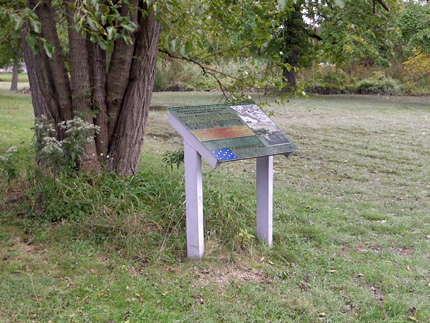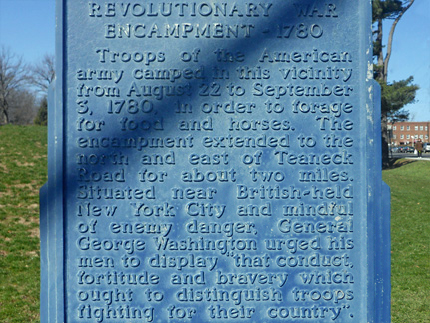





Clarence W. Brett Park at Historic New Bridge Landing
River Rd. and Riverview Ave.
Map / Directions to Clarence W. Brett Park at Historic New Bridge Landing
The park is located next to the site of the "New Bridge," an important crossing over the Hackensack River during the Revolutionary War. The Revolutionary War significance of New Bridge Landing is explained in detail on the River Edge page.
Part of the Hackensack River Greenway in Teaneck, a 3.5-mile trail along the river, goes through the park. For more information, see the Friends of the Hackensack River Greenway in Teaneck website.



1780 Encampment Site
Teaneck Rd. and Cedar Ln. (In front of Holy Name Hospital)
Map / Directions to the 1780 Revolutionary War Encampment Site
The British occupied New York City from late 1776 until the end of the war in 1783. Because of this, General George Washington kept his army in New Jersey for much of the war, where he could keep an eye on New York City and guard against attack by British forces. Washington was trained as a surveyor as a young man, and had an appreciation and understanding of topography; therefore, he chose his encampment sites well. When in New Jersey, he usually positioned the army in locations behind the Watchung Mountains, which provided a layer of protection from British attack, notably in the Morristown and Middlebrook encampments.
The Continental (American) Army encamped in this area from August 22 - September 3, 1780, stretching through Englewood, and Leonia. What made this encampment different from some earlier New Jersey encampments was the closeness to the British troops in New York City. From New York City, British troops could travel by boats across the Hudson River, disembark at the New Jersey Palisades, and then easily reach this area by roads over the generally moderate terrain. In fact, raids were regularly made this way by British and Loyalist forces on the residents of this area throughout the war. [1]
Aware of the danger of attack by British forces, Washington wrote the following in his orders for August 23, 1780: [2]
(To avoid confusion, note that these orders were written by Washington - he is referring to himself in the third person throughout the orders.)
"The Army being now very near the Enemy. The Genl flatters himself every Officer and Soldier will make it a point of Honor as well as duty to keep constantly in Camp and to be at the shortest notice ready to Act as circumstances may require. He is at the same time persuaded, should an opportunity be afforded us that every part of the Army will vie with each other, in the display of that conduct[,] fortitude and bravery which ought to distinguish troops fighting for their Country, for their liberty, for every thing dear to the Citizen, or to the Soldier."
On September 4, the army would move several miles inland, where they would remain until September 20. Troops would encamp along Kinderkamack Ridge, by what is now Van Saun Park in Paramus to Soldier Hill in Oradell. While they were still open to attack by the British, the move placed them behind the added protection of the Hackensack River. [3] As it turned out, no British attack came. The Battle of Springfield, which occurred several months earlier on June 23, ended up being the last major battle fought in the North. The emphasis of the fighting shifted to the southern states, culminating in the decisive Battle of Yorktown on October 19, 1781. [4]

1. ^ For more information about raids made in Bergen County by British troops and/or Tories, see the Cresskill, Demarest, Dumont, Elmwood Park, Hackensack, Harrington Park, and Ridgefield Park pages of this website.
2. ^ General George Washington, After Orders, Headquarters, Aug 23, 1780 Te[a]neck, reprinted in:
Orderly Book of the New Jersey Brigade, July 30 to October 8, 1780, From the Original Manuscript in the New York Public Library (Bergen County Historical Society, 1922) Pages 27-28
Available to be read at Google Books here3. ^ See the Paramus and Oradell pages of this website for more information about the September 4-20 encampment.
4. ^ See the Springfield page of this website for information about the Battle of Springfield.